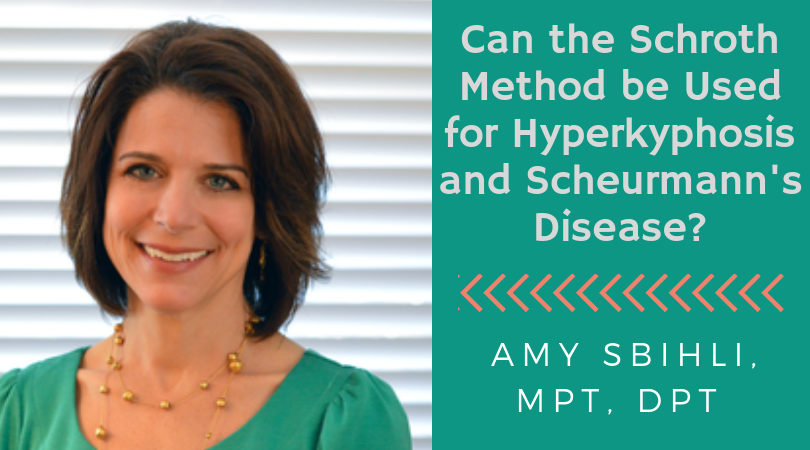Can the Schroth Method be Used for Hyperkyphosis and Scheuermann’s Disease?
Posted on by Amy Sbihli, MPT, DPT
The Schroth Method is often associated with treatment of three-dimensional scoliotic spine deformities. However, there is another form of spine deformity that affects the side view (the front to back inward and outward curvature of the spine) known as hyperkyphosis and Scheuermann’s Disease.
 Hyperkyphosis can be postural or a combination of postural and mild boney changes in the side profile and/or lateral X-ray. A person with hyperkyphosis might look like they just don’t like to stand tall or prefer to slouch in their chair. In this group, bilateral muscle imbalances occur and increase over time.
Hyperkyphosis can be postural or a combination of postural and mild boney changes in the side profile and/or lateral X-ray. A person with hyperkyphosis might look like they just don’t like to stand tall or prefer to slouch in their chair. In this group, bilateral muscle imbalances occur and increase over time.
This postural muscle imbalance can be painful, so most people are very happy to know that the Schroth Method can help them improve their posture if they are willing to make a change and consistently follow specific exercises.
Scheuermann’s kyphosis (named for the Danish radiologist who first wrote about the condition) is a more severe form of hyperkyphosis involving a boney deformity. As with idiopathic scoliosis, there is no known cause, but its origin is multifactorial in nature.
Scheuermann’s kyphosis is described by where the boney deformities occur in the spine. The deformity involves the front part of the spine, known as the vertebral body. In Scheuermann’s kyphosis, three adjacent bodies are wedged, meaning they are taller in the back. This causes the spine to tip forward. It is more often seen in boys than girls.
The same muscle imbalances occur as in hyperkyphosis, but with a bigger effect on the structure of the torso and the individual vertebra. With Schroth, we see very significant changes in a short period of time. With the combination of training general flexibility in the shoulders and hips as well as the use of Schroth to elongate and expand the torso, it is my experience that the patient finds it easier to breath, has less pain and shows improved self-esteem.
If you have questions you can reach Amy at amy@spineacademypt.com.
Amy Sbihli is the Founder and Director of Spine Academy Physical Therapy, PLLC in the Boston area. She is the co-founder of Schroth-Barcelona Institute and an active member of Barcelona Scoliosis Physical Therapy School and SOSORT International education committee. She began working with outpatient orthopedic spine and scoliosis patients in 2004. Amy is certified to practice and teach the Schroth Method through the Barcelona Scoliosis Physical Therapy School (BSPTS) earning her certification in 2005 from the Barcelona Scoliosis Physical Therapy School. Amy received Masters and Doctorate degrees in physical therapy from Washington University in St Louis. She also holds a BA in Kinesiology from the University of Michigan. Treatment expertise includes scoliosis, SI, orthopedic spine, movement dysfunction, and Pilates.

